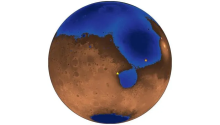You are using an out of date browser. It may not display this or other websites correctly.
You should upgrade or use an alternative browser.
You should upgrade or use an alternative browser.
China's Space Program Thread II
- Thread starter Blitzo
- Start date
The Zhurong Mars rover used its ground-penetrating radar to uncover evidence of ancient coastlines and beaches on Mars. The rover spent a year, from May 2021 to May 2022, moving along the base of a steeply-sloped rock outcrop at the edge of a wide, flat plain.
Along Zhurong's 1.2-mile (1.9-kilometer) route, its ground-penetrating radar beamed radio waves 262 feet (80 meters) down into the Martian ground. The way those radio waves reflected back to the instrument revealed underground features they came into contact with, like the boundaries between layers of rock and sediment. Thirty-three feet (10 meters) beneath the surface, the radar revealed smooth, gently-sloping layers of sand, several yards thick. Those layers appear to run parallel to the rocky cliff, and they rise toward that cliff at a shallow 15-degree slope — which is typical of beaches here on planet Earth.
The buried beach could represent the first evidence of a true ocean from Mars' ancient past, and its presence means the Red Planet must have had an ocean for millions of years — long enough to leave behind the thick layers of sand Zhurong's radar measured. And that ocean must have been fed by rivers, the scientists reason, as those rivers would have dumped sediment into the ocean. Waves would eventually have spread that resulting sediment along the shore, forming a beach that'd have been strikingly familiar to us.
Map depicting where Zhurong (orange) and Perseverance (yellow) landed

Paper:
For when is planned the next mars mission?
The Zhurong Mars rover used its ground-penetrating radar to uncover evidence of ancient coastlines and beaches on Mars. The rover spent a year, from May 2021 to May 2022, moving along the base of a steeply-sloped rock outcrop at the edge of a wide, flat plain.
Along Zhurong's 1.2-mile (1.9-kilometer) route, its ground-penetrating radar beamed radio waves 262 feet (80 meters) down into the Martian ground. The way those radio waves reflected back to the instrument revealed underground features they came into contact with, like the boundaries between layers of rock and sediment. Thirty-three feet (10 meters) beneath the surface, the radar revealed smooth, gently-sloping layers of sand, several yards thick. Those layers appear to run parallel to the rocky cliff, and they rise toward that cliff at a shallow 15-degree slope — which is typical of beaches here on planet Earth.
The buried beach could represent the first evidence of a true ocean from Mars' ancient past, and its presence means the Red Planet must have had an ocean for millions of years — long enough to leave behind the thick layers of sand Zhurong's radar measured. And that ocean must have been fed by rivers, the scientists reason, as those rivers would have dumped sediment into the ocean. Waves would eventually have spread that resulting sediment along the shore, forming a beach that'd have been strikingly familiar to us.
Map depicting where Zhurong (orange) and Perseverance (yellow) landed
View attachment 146661
Paper:
by78
General
Right on cue, the phase II expansion of Hainan Commercial Spaceport has begun. The two new launchpads will be ready for launch services within 18 to 24 months.


Hainan Commercial Spaceport Phase II expansion progress. Foundation piles are being drilled for launchpad no. 3, and ground is being excavated for the foundation of launchpad no. 4.



by78
General
Hainan Commercial Spaceport's propellant and oxidizer production/purification plant has successfully conducted trial operations. The plant is used to produce liquid oxygen and hydrogen as well as purify of liquid methane for the spaceport.


The Jiufeng propellant production facility of Hainan Commercial Spaceport has filled up the first batch of liquid hydrogen tanker trucks, which will carry the hydrogen to launchpad no. 1 for upcoming launches.




Supposedly a Kuaizhou rocket exploded on launch. Does anyone have video/news on this?
There are rumors that this KZ-1A blew up before launch and that FTS was to blame. It is said that Expace won't count this as an orbital launch.Supposedly a Kuaizhou rocket exploded on launch. Does anyone have video/news on this?
We also know that Launch Area 95A may have been damaged, as a Ceres-1 rocket that was planned to launch from the same date had its NOTAM pushed back a day.There are rumors that this KZ-1A blew up before launch and that FTS was to blame. It is said that Expace won't count this as an orbital launch.



